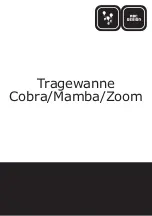
33
XOver Screen
These gain values are intended to be used for system set up, the front panel
gain trim controls being used for fine tuning. The XOver screen gain
adjustments give an overall control of ±15dB relative to the channel input.
Note that limiter thresholds refer to levels at the outputs and are not affected by
the gain settings. The front panel gain trims give an additional ±6dB of
adjustment. Note that when storing programs that the front panel gain trims
will be added into the internal gains to prevent the accidental loss of the
external gain trim information unless the Store Trims function is turned Off.
Refer to Section 14.0, Store and Recall.
These limiter values should be used in conjunction with the input sensitivity
specification for the amplifiers attached to the band outputs. A suggested value
might be 1dB below the amplifier sensitivity value. The FDS-388 limiters have
an infinite compression slope above the user preset threshold value with attack
times automatically linked to the lower band edge frequencies of their related
band. The units for the threshold display are set in the XOver Utility Screen
and are selectable dBu or mV.
Refer to Section 12.0, XOver Utility Screen -
Limit Units.
Note that the output level meters display a value relative to the band limiter
threshold. dB values on the meters are dB below threshold, the 0dB led being
at the onset of limiting.
Refer to Section 3.1, Output Section.
Pressing the encoder will first step through the limiter values and then through
the limiter on/off flags. Each on/off is represented by brackets around the
limiter value. When the brackets are NOT visible, the limiter is ON for that
band. When the brackets are visible, the limiter is OFF for that band but the
meter is still referenced to the limiter threshold. This means that limiter
thresholds can be set up with the limiter off and with the meters still correctly
referenced. If a band has the limiter turned off, the OVER led will be lit
continuously as a warning to the user.
This section allows a fast but basic adjustment of band crossover frequencies.
The user can select between the three band crossover frequencies (the
crossover of the high edge of band A and the low edge of band B for
example), the low edge of band A or the high edge of band D. The crossover
point frequency displayed is the average of the adjacent high and low edge
frequencies. The outer edge frequencies can be set to OUT at their extreme
high and low settings. Note: Each crossover point can be moved throughout
the audio band, no checking is made for a band low edge being set above the
band high edge thereby muting the band output, nor can the FDS-388 know
the frequency capabilities of individual speakers in any system - crossover
edges should be moved with care.
The relative heights of the four bands do not represent any level information -
the bands are set at slightly different heights to aid the user in identifying the
different bands when edge frequencies overlap. Similarly the edges of each
band are only an approximation of the true edge shape. The user should refer
to the Default Screen for a truer representation of the effect of band edges and
band equalisation.
Top Soft Key
Gain/dB
Middle Soft Key
Limit/dBu (or mV)
Bottom Soft Key
FR/Hz (Crossover
Frequency)
Содержание Omnidrive FDS-380
Страница 1: ...1...
Страница 64: ...64 User Notes...
Страница 65: ...65 User Notes...
Страница 66: ...66 User Notes...
















































